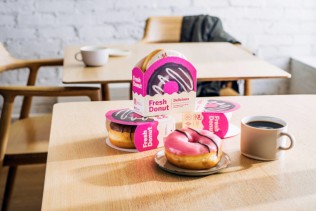
For tasty snacks like doughnuts, plastic has typically been used to keep the product intact and safe – and help keep our fingers clean. But with Metsä Board’s help, producers can change to paperboard-based packaging that does the same job but is easily recyclable and compostable. Hélène Lehtinen, Director of Barrier Development at Metsä Board, explains how brands can make the switch with confidence.
Plastic reduction is an extremely hot topic in the food industry today as brands respond to pressure from regulators, investors and consumers to adopt more ecological packaging materials. In their quest to reduce their use of plastics, food producers need help to assess the performance and safety of more sustainable alternatives like paperboard.
Recommendations based on hard facts
“In a nutshell the role of food packaging is to keep what’s inside, inside and what’s outside, outside,” says Hélène. “That means protecting the food from spoilage and damage during storage and transport, and making sure none of the contents can escape onto shelves or our hands. Plastic is popular in the food industry because of its excellent barrier properties, especially in demanding end uses like packaging for meat and fish, and for greasy products like doughnuts,” she explains.
This is why it’s common to see doughnuts in packaging that includes a plastic wrapping or polyethylene (PE) coated materials. “Our role is to be an educator for food producers, an expert partner who can demonstrate, based on hard facts and thorough testing, how they can cut down on overpackaging and reduce their use of plastic by switching to a recyclable, compostable barrier paperboard alternative like MetsäBoard Prime FBB EB,” says Hélène.
MetsäBoard Prime FBB EB is a fully coated, lightweight paperboard with an light barrier that provides medium protection against grease and moisture. It can be recycled in paper or paperboard waste streams.
Cooking up a recipe for success together
No two products are the same, so when assessing the suitability of a new packaging material, thorough testing is essential to provide proof that it will be safe and perform exactly as designed. “We work closely with the customer to get to know the product properties, the end-use application, and the conditions that the packaging will face. At our Excellence Centre in Äänekoski we have the capabilities to replicate the manufacturing and storage conditions in climate chambers so we can demonstrate how our paperboard alternative will perform in real life,” explains Hélène.
“For doughnut packaging, grease resistance is of course an important property, but we also need to know whether the product is packed when it is warm or cold, because warm products can result in condensation forming. We also need to understand the expected storage conditions as we may need to show that the board’s strength properties will hold up in moist conditions,” Hélène says.
Performing this kind of testing on behalf of customers speeds up the packaging development process considerably and ensures that Metsä Board can recommend the optimal paperboard product for each individual customer’s application. Metsä Board can provide reliable data that customers can use to enhance their sustainability credentials when switching to a product like MetsäBoard Prime FBB EB. “We can clearly demonstrate, in terms of tonnes, how much less plastic they will use, and they can confidently say that their packaging will be fully recyclable and compostable too,” Hélène points out.
“There is no magic one-size-fits-all solution when seeking alternatives to plastic for packaging foods. Creating a safe, sustainable and high-performance packaging design means bringing together experts from several different areas to understand the customer’s needs, product characteristics and production processes inside out. This is where having Metsä Board as a partner brings tremendous value,” Hélène concludes.
Photo: Metsä Board



